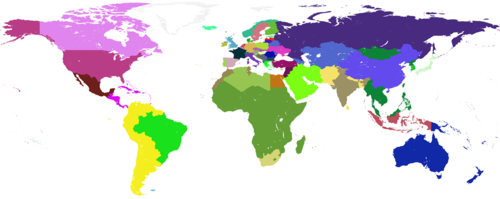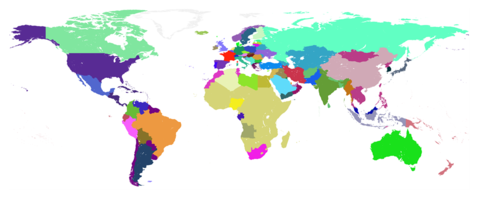Difference between revisions of "Spatial dimension - POLES"
m (1 revision imported) |
|||
| Line 3: | Line 3: | ||
|DocumentationCategory=Spatial dimension | |DocumentationCategory=Spatial dimension | ||
}} | }} | ||
| + | |||
| + | == Energy and emissions balances == | ||
| + | |||
| + | The geographical representation is based on the importance of countries in energy consumption and GHG emissions. POLES describes full energy and emissions balances for 57 geographical units: 45 countries and 12 residual regions covering the World. Countries include all OECD (1990) countries and large non-OECD countries. All EU28 Member States and nearly all G20 countries are thus explicitely represented. | ||
| + | |||
| + | Land use and renewables potentials (wind, solar, biomass) follow the geographical representation of the energy balances. | ||
| + | |||
| + | The international air and maritime bunkers are represented separately. | ||
| + | |||
| + | Energy demand at World level, and related emissions, is then the sum of all regions and bunkers. | ||
| + | |||
| + | [[File:36405501.png|none|500px|thumb|<caption>POLES - the World in 57 energy balances</caption>]] | ||
| + | |||
| + | |||
| + | == Fossil fuels supply == | ||
| + | |||
| + | The fossil fuels supply side is more detailed, with all important producing countries being represented allowing a very precise description of the supply side and a good understanding of the related issues at stake. | ||
| + | |||
| + | Oil and gas productions are described for 80 producers. | ||
| + | |||
| + | [[File:36405502.png|none|500px|thumb|<caption>POLES - 80 oil and gas producers</caption>]] | ||
| + | |||
| + | Coal production distinguishes 74 producers, including an infra-national disaggregation for large producers (USA, China, Australia, India). | ||
| + | |||
| + | |||
| + | == Trade == | ||
| + | |||
| + | Producing regions and consuming regions are linked through energy markets. | ||
| + | |||
| + | * Oil producers supply a single world "pool" market | ||
| + | * Large gas producers export towards 14 regional consuming markets; small gas producers only supply domestic consumption | ||
| + | * Large coal producers export towards 15 regional consuming markets; small coal producers only supply domestic consumption | ||
| + | * Solid or liquid biofuels producers export towards a single world "pool" market | ||
| + | * A single world production of uranium is modelled | ||
Revision as of 13:15, 20 October 2016
| Corresponding documentation | |
|---|---|
| Previous versions | |
| Model information | |
| Model link | |
| Institution | JRC - Joint Research Centre - European Commission (EC-JRC), Belgium, http://ec.europa.eu/jrc/en/. |
| Solution concept | Partial equilibrium (price elastic demand) |
| Solution method | SimulationRecursive simulation |
| Anticipation | Myopic |
Energy and emissions balances
The geographical representation is based on the importance of countries in energy consumption and GHG emissions. POLES describes full energy and emissions balances for 57 geographical units: 45 countries and 12 residual regions covering the World. Countries include all OECD (1990) countries and large non-OECD countries. All EU28 Member States and nearly all G20 countries are thus explicitely represented.
Land use and renewables potentials (wind, solar, biomass) follow the geographical representation of the energy balances.
The international air and maritime bunkers are represented separately.
Energy demand at World level, and related emissions, is then the sum of all regions and bunkers.
Fossil fuels supply
The fossil fuels supply side is more detailed, with all important producing countries being represented allowing a very precise description of the supply side and a good understanding of the related issues at stake.
Oil and gas productions are described for 80 producers.
Coal production distinguishes 74 producers, including an infra-national disaggregation for large producers (USA, China, Australia, India).
Trade
Producing regions and consuming regions are linked through energy markets.
- Oil producers supply a single world "pool" market
- Large gas producers export towards 14 regional consuming markets; small gas producers only supply domestic consumption
- Large coal producers export towards 15 regional consuming markets; small coal producers only supply domestic consumption
- Solid or liquid biofuels producers export towards a single world "pool" market
- A single world production of uranium is modelled

